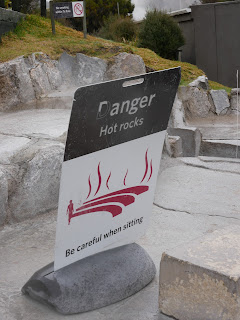After a refreshing bowl of soup, we returned to the van for the thirty minute drive to Te Puia Cultural Center. By this point the rain seemed to be done for the day, not to say that the sun was out only that we were not going to get soaked. Our guide arranged for us to have a 1:30 pm tour, which gave us just enough time to inhale a pre-made sandwich. The timing was tighter than planned, probably because we paused for soup at the last place.
At Wai-O-Tapu the women from Hong Kong were dropped off at the same time, and the others were dropped off at Te Puia. Their tour included a Maori performance and a traditional lunch (which the vegetarian in the group said did not include enough meatless options for her). In hindsight, I should have chosen that option. Our visit included a tour of the school where they teach traditional arts, a chance to see kiwis, and their geothermal areas.
In the end, it wasn't enough of a cultural experience for us. We were hoping to learn more about the Maori than their arts -- are they matrilineal or patrilineal? Are they nomadic or do they stay in the same place? What were their lives like pre-Colonization? We wanted the questions answered on a tour about Lenape life pre-Colonization that Ashley used to participate in at the Churchville Nature Center. We were also not told about the Maori architecture and learn about family life -- sections highlighted on the brochure. This was not that tour.
The women from Mexico and the guy from Switzerland went to Wai-O-Tapu, the women from Hong Kong went to the spa. Felt like a lot of running around for the driver and we were only seven people in a 12-person van.
There were multiple tours happening at the same time. Don and I were joined by another couple at the last moment. When we arrived at 1 pm the room seemed to be overflowing with people, so we were grateful for practically having a private tour. As we were gathering, a group was told they had to wait for the 2 pm tour, which I didn't understand. I also got the sense their English was not strong, so they may have been waiting for a tour guide who spoke their language.Our tour started in the New Zealand Maori Arts and Crafts Institute, which was established in the 1920s to make sure Maori culture continued. To put this in context, the European settlers arrived in 1840 and a mere eighty years later someone recognized the need to preserve their culture. Our entry fee included supporting this institute.
The trade school consists of three sections: two to learn carving, and one for weaving. Traditionally it is the boys who learn carving, and the girls who learn weaving. I tried to nail them on whether or not that is a requirement or just tradition and did not get much of an answer.

Downstairs they work with woodcarving, another three year program for boys. The were working on red pine when we were there, but they work on different types of wood. They do not cut down trees to find raw materials. Sometimes people will reach out to them when a tree has fallen so they can rescue the tree and turn it into something. They, too, use a combination of ancient and modern techniques to create their intricate art.
The third program is a two-year program to learn how to weave using ancient techniques. The core material is flax, which is green and supple when it is growing, and dries brown and sturdy. Their baskets can be used to cook food in the geothermal hot springs. It is heat resistant and made well, can last a lifetime. Sometimes they incorporate kiwi feathers that have been found on the ground.
On the tour I thought how fascinated Don's mom would have been by the process. For example, the make the patterns on these ceremonial clothes the flax is stripped away in small sections before it is dipped.
 |
| The shells give the eyes a creepy look |
Learned the mud pools were used by warriors before going into battle. Today the mud is used to heal cancer patients.





















No comments:
Post a Comment